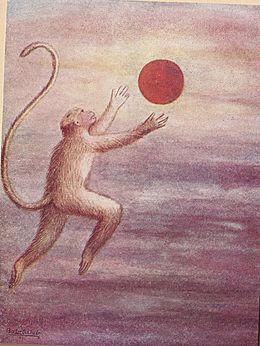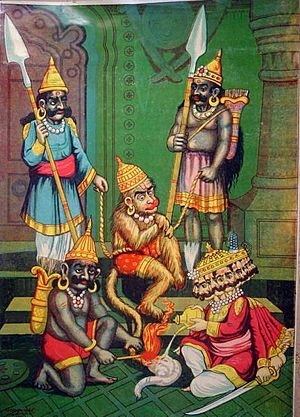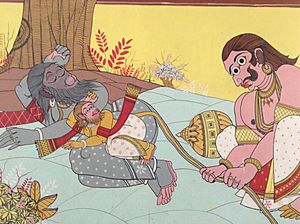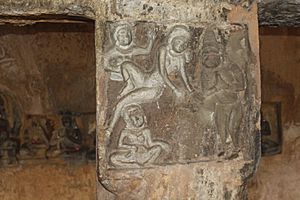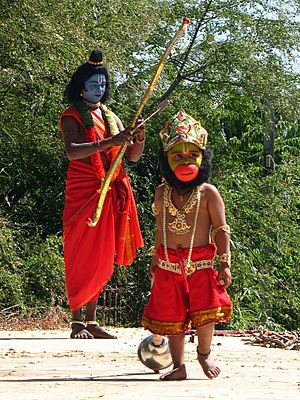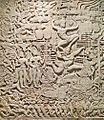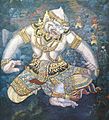Hanuman facts for kids

Hanuman ( Sanskrit: हनुमान्, IAST: Hanumān), also known as Maruti, Bajrangabali, and Anjaneya, is a deity in Hinduism. He is an avatar of Shiva. Hanuman is the patron of martial arts and an example of courage.
He is mentioned in the Ramayana, the Mahabharata and various Puranas.
Hanuman is usually portrayed with other central figures of the Ramayana - Rama, Sita and Lakshmana. He carries weapons such as a gada (mace) and thunderbolt (vajra).
Contents
Meaning of the name
The meaning or origin of the word "Hanuman" is unclear. In the Hindu pantheon, deities typically have many synonymous names, each based on some noble characteristic, attribute, or reminder of a deed achieved by that deity. One interpretation of "Hanuman" is "one having a disfigured jaw". This version is supported by a Puranic legend wherein infant Hanuman mistakes the Sun for a fruit, heroically attempts to reach it, and is wounded in the jaw for his attempt by Indra the King of Gods.
Birth and childhood
Hanuman's parents were Anjana and Kesari. He is also called the son of the deity Vayu (Wind god). He spent his childhood in Kishkindha.
Legend has it that one morning, Hanuman was hungry and saw the rising red-colored sun. Mistaking it for a ripe fruit, he leapt up to eat it. The king of gods Indra intervened and struck Hanuman with his thunderbolt. It hit Hanuman on his jaw, and he fell to the earth dead with a broken jaw. Hanuman's father Vayu (air) became upset and withdrew all the air on Earth. The lack of air created immense suffering to all living beings. This led Shiva to intervene and resuscitate Hanuman, which in turn prompted Vayu to return to the living beings.
In another version of this legend, Hanuman's leap for the sun proves to be fatal and he is burnt to ashes from the sun's heat. His ashes fall onto the earth and oceans. Gods then gather the ashes and his bones from land and, with the help of fishes, re-assemble him. They find everything except one fragment of his jawbone. His great-grandfather on his mother's side then asks Surya to restore the child to life. Surya returns him to life, but Hanuman is left with a disfigured jaw.
Hanuman had unique powers and strength. He was immortal. Fire, water and wind could not harm him. He could move to any place as fast as wind.
Ramayana
When Rama's wife, Sita, was kidnapped, Rama and his brother Lakshmana send scouts in all four directions to search for her. The group travels all the way to the southernmost tip of India, where they encounter the ocean with the island of Lanka (modern day Sri Lanka) visible in the horizon. The group wishes to investigate the island, but none can swim or jump so far. However, Hanuman uses his divine powers to transform into the size of mountain, and fly across the narrow channel to Lanka.
Upon landing, he discovers a city populated by the Lanka king Ravana and his demon followers, so he shrinks down to the size of an ant and sneaks into the city. After searching the city, he discovers Sita in a grove, guarded by demon warriors. When they all fall asleep, he meets with Sita and discusses how he came to find her. She reveals that Ravana kidnapped her and is forcing her to marry him soon. He offers to rescue her but Sita refuses, stating that her husband must do it (a belief from the time of ancient India).
What happens next differs by account, but a common tale is that after visiting Sita, he starts destroying the grove, prompting his capture. Regardless of the tale, he ends up captured in the court of Ravana himself, who laughs when Hanuman tells him that Rama is coming to take back Sita. Ravana orders his servants to light Hanuman's tail on fire as torture for threatening his safety. However, every time they put on an oil-soaked cloth to burn, he grows his tail longer so that more cloths need to be added. This continues until Ravana has had enough and orders the lighting to begin. However, when his tail is lit, he shrinks his tail back and breaks free of his bonds with his superhuman strength. He jumps out a window and jumps from rooftop to rooftop, burning down building after building, until much of the city is ablaze. Seeing this triumph, Hanuman leaves back for India.
When he returns, he tells his scouting party what had occurred, and they rush back to Kishkindha, where Rama had been waiting all along for news. Hearing that Sita was safe and was awaiting him, Rama gathered the support of Sugriva's army and marched for Lanka. Thus begins the legendary Battle of Lanka.
Throughout the long battle, Hanuman played a role as a general in the army. During one intense fight, Lakshmana, Rama's brother, was fatally wounded; it was thought that he would die without the aid of a herb from a Himalayan mountain. Hanuman was the only one who could make the journey so quickly, and was thus sent to the mountain.
Upon arriving, he discovered that there were many herbs along the mountainside, and did not want to take the wrong herb back. So instead, he grew to the size of a mountain, ripped the mountain from the Earth, and flew it back to the battle. This act is perhaps his most legendary. A chunk of this mountain was said to have fallen down and the present day “Mount Roomassala” is believed to be the fallen piece.
In the end, Rama revealed his divine powers as the incarnation of the God Vishnu, and slew Ravana and the rest of the demon army. Finally, Rama returned to his home of Ayodhya to return to his place as king. After blessing all those who aided him in the battle with gifts, Rama gave Hanuman his gift, who threw it away. Many court officials, perplexed, were angered by this act. Hanuman replied that rather than needing a gift to remember Rama, he would always be in his heart. Some court officials, still upset, asked him for proof, and Hanuman tore open his chest, which had an image of Rama and Sita on his heart. Now proven as a true devotee, Rama cured him and blessed him with immortality, but Hanuman refused this and asked only for a place at Rama's feet to worship him. Touched, Rama blessed him with immortality anyway. Like Shesha Nag, Hanuman would live on after the kalpa (destruction of the universe).
Mahabharata
Centuries after the events of the Ramayana, and during the events of the Mahabharata, Hanuman is now a nearly forgotten demigod living his life in a forest. After some time, his spiritual brother through the god Vayu, Bhima, passes through looking for flowers for his wife. Hanuman senses this and decides to teach him a lesson, as Bhima had been known to be boastful of his superhuman strength (at this point in time supernatural powers were much rarer than in the Ramayana but still seen in the Hindu epics). Bhima encountered Hanuman lying on the ground in the shape of a feeble old monkey. He asked Hanuman to move, but he would not. As stepping over an individual was considered extremely disrespectful in this time, Hanuman suggested lifting his tail up to create a passage. Bhima heartily accepted, but could not lift the tail to any avail.
Bhima, humbled, realized that the frail monkey was some sort of deity, and asked him to reveal himself. Hanuman revealed himself, much to Bhima's surprise, and the brothers embraced. Hanuman prophesied that Bhima would soon be a part of a terrible war, and promised Bhima that he would sit on the flag of his brother Arjuna's chariot and shout a battle cry for Bhima that would weaken the hearts of his enemies. Content, Hanuman left his brother to his search, and after that prophesied war, would not be seen again until early 1600s.
Significance
In 17th-century north and western regions of India, Hanuman emerged as an expression of resistance and dedication against Islamic persecution.
In the colonial and post-colonial era he has been a cultural icon, representing the right of Hindu people to express and pursue their forms of spirituality and religious beliefs (dharma). Political and religious organizations have named themselves after him. Political parades or religious processions have featured men dressed up as Hanuman, along with women dressed up as gopis (milkmaids) of god Krishna, as an expression of their pride and right to their heritage, culture and religious beliefs.
Temples and shrines

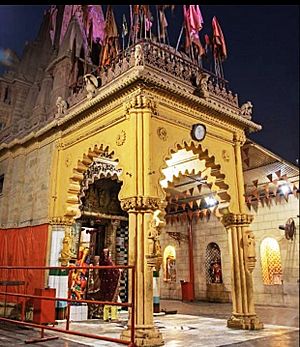
Hanuman is often worshipped all over India.
Tuesday and Saturday of every week are particularly popular days at Hanuman temples. Some people keep a partial or full fast on either of those two days.
Major temples and shrines of Hanuman include:
- The oldest known independent Hanuman temple and statue is at Khajuraho, dated to about 922 CE from the Khajuraho Hanuman inscription.
- Mahavir Mandir in Patna is one of the holiest Hindu temples dedicated to Hanuman located in Bihar, India.
- Bajrang bali Hanuman temple - Lakdikapool, Hyderabad.
- Hanumangarhi, Ayodhya, is a 10th-century temple dedicated to Hanuman.
- Shri Panchmukhi Hanuman Mandir is a 1,500-year-old temple in Pakistan. It is located in Soldier Bazaar in Karachi, Pakistan. The temple is highly venerated by Pakistani Hindus as it is the only temple in the world which has a natural statue of Hanuman that is not man-made (Swayambhu).
- Jakhu temple in Shimla, HImachal Pradesh contains a monumental 108-foot (33-metre) statue of Hanuman and is the highest point in Shimla.
- The tallest Hanuman statue is the Veera Abhaya Anjaneya Swami, standing 135 feet tall at Paritala, 32 km from Vijayawada in Andhra Pradesh, installed in 2003.
- Chitrakoot in Madhya Pradesh features the Hanuman Dhara temple, which features a panchmukhi statue of Hanuman. It is located inside a forest, and it along with Ramghat that is a few kilometers away, are significant Hindu pilgrimage sites.
- The Peshwa era rulers in 18th century city of Pune provided endowments to more Hanuman temples than to temples of other deities such as Shiva, Ganesh or Vitthal. Even in present time there are more Hanuman temples in the city and the district than of other deities.
- One of the major temples of Hanuman is Hanuman Temple Salangpur in based in Salangpur, Gujarat. There is also a statue of Hanuman which is 54 ft tall.
- Outside India, a major Hanuman statue has been built by Tamil Hindus near the Batu caves in Malaysia, and an 85-foot (26 m) Karya Siddhi Hanuman statue by colonial era Hindu indentured workers' descendants at Carapichaima in Trinidad and Tobago. Another Karya Siddhi Hanuman Temple has been built in Frisco, Texas in the United States.
Festivals and celebrations
Hanuman is a central figure in the annual Ramlila celebrations in India, and seasonal dramatic arts in southeast Asia, particularly in Thailand; and Bali and Java, Indonesia. Ramlila is a dramatic folk re-enactment of the life of Rama according to the ancient Hindu epic Ramayana. The Ramlila festivities were declared by UNESCO as one of the "Intangible Cultural Heritages of Humanity" in 2008.
Hanuman's birthday is observed by some Hindus as Hanuman Jayanti. It falls in much of India in the traditional month of Chaitra in the lunisolar Hindu calendar, which overlaps with March and April. However, in parts of Kerala and Tamil Nadu, Hanuman Jayanti is observed in the regional Hindu month of Mārgaḻi, which overlaps with December and January. The festive day is observed with devotees gathering at Hanuman temples before sunrise, and day long spiritual recitations and story reading about the victory of good over evil.
Lineage
Some sources state that Hanuman was never married and had no children. However, some regional sources mention that Hanuman married Suvarchala, the daughter of Surya (Sun-God).
However, once Hanuman was flying above the seas to go to Lanka, a drop of his sweat fell in the mouth of a crocodile, which eventually turned into a baby. The monkey baby was delivered by the crocodile, who was soon retrieved by Ahiravana, and raised by him, named Makardhwaja, and made the guard of the gates of Patala, the former's kingdom. One day, Hanuman, when going to save Rama and Lakshmana from Ahiravana, faced Makardhwaja and defeated him combat. Later, after knowing the reality and after saving both, he made his son, the king of Patala.
Images for kids
-
Standing Hanuman, Chola Dynasty, 11th century, Tamil Nadu, India
-
Numerous 14th-century and later Hanuman images are found in the ruins of the Hindu Vijayanagara Empire.
-
Roadside Hanuman shrine south of Chennai, Tamil Nadu.
-
Hanuman murti seated in meditation in lotus asana
-
41 meters (135 ft) high Hanuman monument at Paritala, Andhra Pradesh
-
Hanuman relief in Prambanan temple, Indonesia
-
Hanuman wayang (puppetry) in Indonesian culture
See also
 In Spanish: Hánuman para niños
In Spanish: Hánuman para niños


